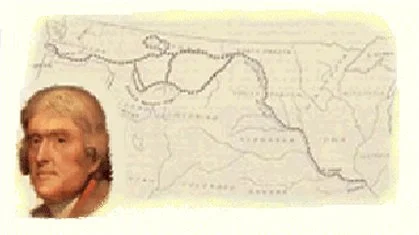Visitors Guide to Lewis & Clark Sites
in the Middle Mississippi River Valley
Cahokia Courthouse State Historic Site
Cahokia, Illinois
greatriverroad.com’s coverage of the Corps of Discovery Expedition begins in the south where the Mississippi River meets the Ohio River and ends with coverage of historic St. Charles, Missouri. Included are the two national sites along the Lewis and Clark National Historic Trail in Hartford, Illinois and St. Charles, Missouri. greatriverroad.com also covers Eastern Legacy sites such as Fort Kaskaskia and the Cahokia Courthouse. Additionally, we have included many of the sites that have been selected by the Illinois and Missouri Lewis and Clark Bicentennial Commissions. Finally, we have added several sites that were not recognized by any of the above official organizations but that we feel that provide insight into the Expedition and enhance the visitor's experience. The sites on this page are not a full list of Lewis and Clark sites in the states of Illinois and Missouri.
Page 2 of 3
Sites are listed in a general chronological and a general geographical (south to north) order.
Sainte Genevieve
Ste. Genevieve County, Missouri
On November 28, 1803, Clark wrote "and after passing some verry swift water which was comfd [confined?] between Sand bars, I arrived at the Landing opposit old St. Genevie, (or Misar.") Situated across the river from Fort Kaskaskia, the Corps destination to recruit additional men, was Old Ste. Genevieve, once called Misery. Old Ste. Genevieve was relocated further inland because of frequent flooding and many of the buildings in the Historic District of Ste. Genevieve date back to the time when Lewis and Clark passed by.
Fort Kaskaskia State Historic Site
Ellis Grove, Illinois
The Corps of Discovery arrived in Kaskaskia on November 29, 1803. More than a dozen men were recruited here including members of the U.S. Army garrisons stationed at the fort. The Corps replenished supplies, took scientific readings, and gathered information from the local merchants and traders. Clark left with the men and the boats on December 3 with Lewis leaving on horseback on December 5.
Magnolia Hollow Conservation Area
Ste. Genevieve County, Missouri
On December 4, 1803, after leaving Fort Kaskaskia, Clark noted the mouth of Gabouri Creek. Upriver from this point he noted "the highlands juts to the river and form a most tremendious Clift of rocks..." The Magnolia Hollow Conservation Area, north of Ste. Genevieve, preserves these forested highlands and has an observation deck overlooking the Mississippi River.
Fort de Chartres State Historic Site
Prairie du Rocher, Illinois
Clark noted that the Expedition passed by the ruins of "Old fort Charters" on December 4, 1803. Fort de Chartres, once the French administrative center for the region and last French fort to surrender to the British after the French and Indian War, fell victim to the ravages of the Mississippi River. The reconstructed fort is now an Illinois State Historic Site.
Cahokia Courthouse
Cahokia, Illinois
Cahokia was the first French settlement in the middle Mississippi Valley, being established in 1698 and for many years was the principal city in the region. Lewis arrived in Cahokia in December of 1803, and made contact with the influential residents of this town located across the river from St. Louis. Most notable of these were Nicholas Jarrot and John Hay who acted as interpreters when Lewis crossed the river to meet with the Spanish Governor Carlos Dehault Delassus. Clark arrived with the men and the boats on December 10 and waited for Lewis to return from St. Louis. When denied permission by Delassus to go up the Missouri River, the choice was made to set up winter quarters at the mouth of the Wood River, directly across from the mouth of the Missouri River. Cahokia acted as post office and as a source of information and supplies during the Expedition's stay in the region. The Cahokia Courthouse is one of the few surviving human-made structures that Lewis and Clark visited.
Cahokia Mounds State Historic Site
Collinsville, Illinois
On a hunting expedition on January 9, 1804 Clark came across the northwest edge of the Cahokia Mounds, at present Mitchell, Madison County, Illinois. The mounds that Clark found have been obliterated, but similar mounds can be found at Cahokia Mounds State Historic Site.
Museum At The Gateway Arch
St. Louis, Missouri
By the time Lewis and Clark reached the St. Louis area in 1803, the town was beginning to eclipse Cahokia in importance. Lewis spent most of his time during the winter of 1803-1804 in St. Louis. Although Clark spent most of his time at Camp River Dubois, he made frequent trips to St. Louis which served as a major source for supplies, information, and entertainment. On March 10, 1804, the Louisiana Purchase Transfer Document, transferring the Upper Louisiana Territory from Spain to France to the United States, was signed at ceremonies taking place March 9 and 10, 1804, on the St. Louis riverfront. The Expedition ended its journey to fanfare in St. Louis on September, 23, 1806. The site of colonial St. Louis is now occupied by the Jefferson National Expansion Memorial which includes the Gateway Arch, The Museum of Westward Expansion, and the Odyssey Theatre.














